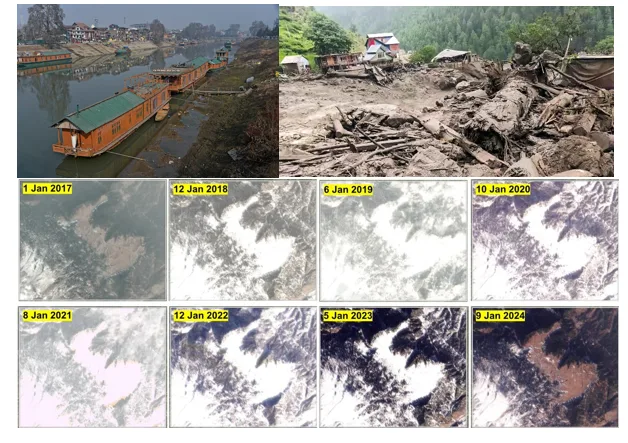Jammu and Kashmir, often known as “Paradise on Earth,” has long been admired for its snow-capped mountains, green valleys and crystal-clear rivers. Yet today, this natural wonder faces a grave challenge as the impact of climate change increasingly reshapes its environment and the lives of its people. The region’s fragile ecosystem, consisting of glaciers, rivers, forests and wetlands, is highly sensitive to rising global temperatures. Over the last few decades, unpredictable weather, warmer winters, and shrinking glaciers have begun to alter the land and the social and economic fabric of this Himalayan territory.
The melting of glaciers, which serve as the lifelines for rivers like the Jhelum, Chenab and Indus, has become one of the most visible signs of environmental distress. Studies and satellite imagery indicate that glaciers such as Kolahoi, Thajiwas and Machoi have been receding rapidly, with Kolahoi alone losing more than a fifth of its size in the last thirty years. Initially, excess melting leads to floods, while in the long run, it threatens water availability for drinking, irrigation and hydropower generation. The irregular flow of rivers now affects farming and fisheries, creating uncertainty for those who rely on them. This changing hydrology poses a long-term danger to both livelihoods and ecological balance.
Equally concerning are the shifting weather patterns that have transformed the traditional climate of Jammu and Kashmir. Once known for long, snow-filled winters and mild summers, the region now experiences warmer winters and shorter snow periods. Reports from the Indian Meteorological Department show a steady rise in average temperatures over the last four decades. Rainfall has also become erratic, alternating between prolonged dry spells and heavy downpours. The 2014 floods that submerged much of Srinagar remain a painful reminder of how unpredictable rain can lead to disaster. In recent years, unseasonal rainfall and hailstorms have damaged orchards and farmlands, especially affecting apple cultivation—one of the cornerstones of Kashmir’s economy.
Agriculture and horticulture, which form the backbone of the region’s rural economy, are under increasing stress. Traditional crops such as rice, maize and saffron are struggling due to irregular rainfall and rising temperatures. In Pampore, saffron fields are drying up as groundwater levels fall, while in areas like Shopian and Baramulla, apple orchards face premature flowering and frequent pest attacks. Farmers who once relied on consistent weather cycles now grapple with uncertainty, forcing them to adapt their practices in order to survive. The decline in crop productivity not only affects income and also threatens the food security of many rural families.
The biodiversity and ecological wealth of Jammu and Kashmir are also being tested. The region’s forests and mountains host rare species such as the Hangul deer, snow leopard and Himalayan black bear, but their habitats are shrinking as temperatures rise. Many species are being forced to move to higher altitudes in search of cooler conditions, making survival increasingly difficult. Wetlands like Hokersar, Wular and Anchar, once teeming with migratory birds, are now shrinking due to a mix of human encroachment and climate-induced drying. The loss of these wetlands, which act as natural flood buffers and carbon sinks, intensifies the overall impact of climate change. This environmental imbalance affects tourism and other sectors that depend on natural beauty, adding further strain to the region’s economy.
For the people of Jammu and Kashmir, climate change is no longer a distant issue—it has become a daily reality. Farmers face crop failures, houseboat owners on Dal Lake worry about receding water levels and those dependent on tourism are affected by erratic snowfall and natural hazards. The rhythm of life that once followed predictable seasons and festivals is gradually shifting. Yet amidst these challenges, there are reasons for hope. The government, along with environmental groups and local communities, is working on measures such as reforestation, wetland restoration and the promotion of climate-resilient crops. Renewable energy projects in Ladakh and Kashmir, coupled with eco-conscious tourism, can pave the way toward sustainability. Building awareness and involving communities in conservation are equally essential to protect this fragile ecosystem. The story of Jammu and Kashmir serves as a reminder of how deeply human life is intertwined with nature and how collective, immediate action is needed to preserve this paradise before its beauty fades beyond recovery.


